How Freshwater Deep Sand Beds Work
- Thread starter DeeDeeK
- Start date
You are using an out of date browser. It may not display this or other websites correctly.
You should upgrade or use an alternative browser.
You should upgrade or use an alternative browser.
Nice write-up, DeeDeeK.
gotta agree with slappy here. i've enjoyed your posts a lot
Thank you SO MUCH! As you can probably tell, I spend a lot of time thinking about this stuff, reading about it, and then trying to apply it. Really, it is a pleasure to write it out. It also helps me get my thoughts in order, which usually leads to some new theory or observation to think about and apply.
I know that somewhere on this site I've posted a photo or two of my aquarium but I'll attach one taken today to this post, to show how rich and happy the plants and fish are.
I have been trying to sort out all the trial and error and learning I've been through so far and make a systematic approach to setting up a successful FWDSB aquarium that will reliably perform as well or better than the one I've got now.
That said, I've finally picked out a tank to get, probably this or next month. A LFS (the one with cruddy, sickly fish) sells hardware cheap and has a Nanocube Deluxe 24g for $200.00. I plan to get this and to replace the 50/50 lights with 10000k or hopefully something between 5000k and 6700k if I can find one easily enough. Also, the filter is too powerful for my purposes so I'll figure out a way to customize it because I prefer water that seems almost still like a pond, despite common wisdom that tanks need filters rated for higher than their gallonage. Probably it can be done by replacing the powerhead in the filter.
Anyhow, once the lights and filter are corrected I'll try and follow my own advice in setting up. I'll lay down about 3" of my loose packing sand mixed in order to get a jump start on the mulm with a smidgen (really, just a smidgen) of fish food I'm gonna grind up into a super fine powder and then I'll use the trusty ol' turkey baster to suck up a bunch of sand from my B9 9gal tank and seed the new tank. I'll plant it fairly heavily by stealing from the B9, which I've used to propagate more plants than fit quite comfortably anymore. I'll test the water daily until I'm confident it's cycled and the comes the fishies, worms, snails, planaria, and shrimps I'm going to transfer from the B9. Then the B9 gets handed down to a friend who wants to get into the hobby. Voilá! I bet you nickel it works out! I'm thinking I'm gonna just use the filter for mechanical filtration and circulation and take out the biomedia. I'm pretty confident the DSB is biological filter enough so long as it has its plants and critters to keep the sand open and boost its performance.
I'm SO EXCITED to see my theories made formal and put into practice! Plus I'm just so excited to have a new tank and the chance to tinker with its filter.
So, here's some photos of my current tank, an Odyssea B9 9gal. It has an 18w 12000k CF (I couldn't find a 5500k, my favored color temperature, locally and I hate to mail order). The filter is a weak little guy, rated at best for 5 gallons and is positioned so its outflow disrupts and circulates the surface layer in order to facilitate oxygen absorption. I dismantled the original, built-in filter which was an overhead wet/dry jobby. There is a little heater and no air pump, air stone, or other aerator. I could write volumes about gas exchange, oxygenation, and why you don't need air pumps of any sort or the size power filters everybody seems to think you need. In keeping with my mania for mulm, I don't want a filter that will suck it up before it can sink into the substrate. Ok, the photos. I included one from yesterday (the slightly darker, less cloudy one where a blue ram and a marbled hatchetfish are both visible) but the others are from today. Oh, and those white cylinders with the holes are old sintered glass biomedia which were used in a power filter well beyond their useful life so I don't believe they're contributing much to the biological filter compared to the DSB. They're in there to create sites where blackworms can hide out that the kuhlis can't easily dig them out. They hide in the sand under the media and stick their tails out from under them, and most fish just can't manage to get 'em. This allows there to be some permanent worm colonies not requiring re-seeding every so often. Also, baby shrimp seem to love hanging out in the central hole.
Gosh, I have to admit it's a little embarrassing but my tank is a tad cloudy and I'm not sure why. I thought I'd kicked up a bunch of mulm out of the sand the other day but now I'm suspecting a dead fish hiding back in the milfoil. I'm very sure I haven't overfed and I've tested the water and it comes out perfect at 0,0,10. Maybe adding the blue ram, which I did last week, put the bioload a little over the edge. I know I've been pushing it in anticipation of a move to the new, larger tank.
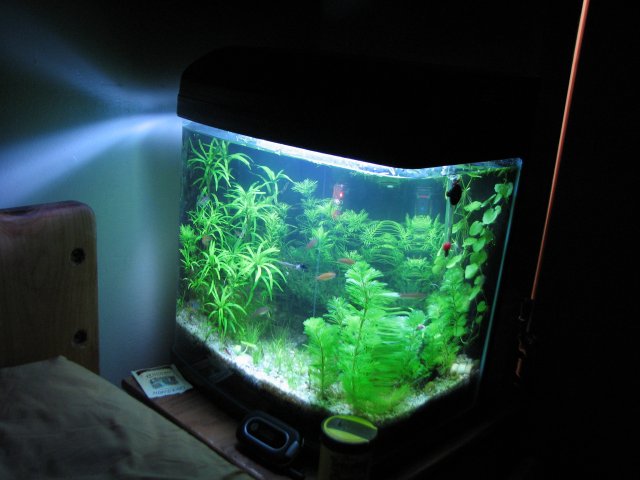
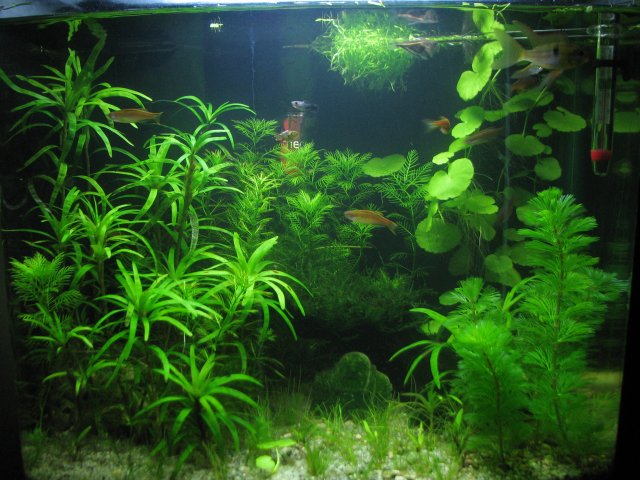
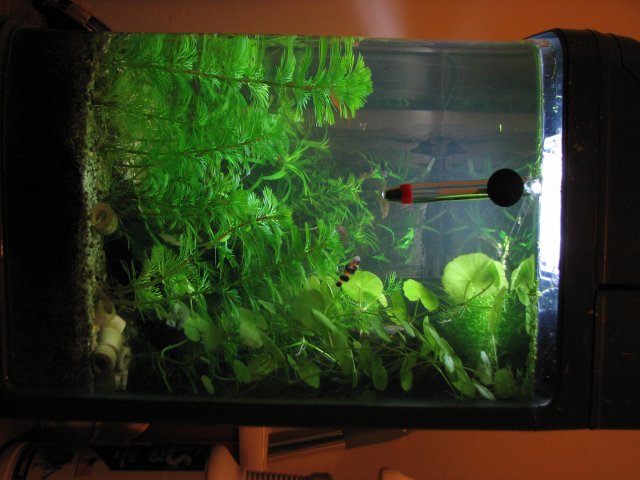
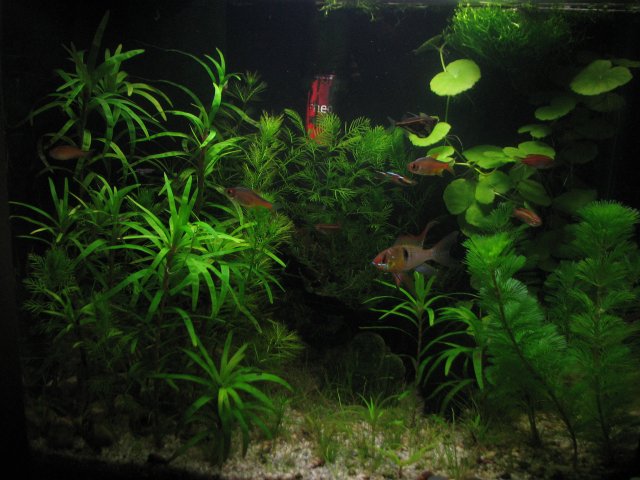
My favorite dead fish!
As mentioned in the blackworms thread, I had a dwarf gourami which died of fish TB (I think). I buried it deep under the sand about a year and a half ago to see if it would create a scary anoxic zone and also to see if it might make good fertilizer. I think it did both but I planted cabomba near it on the theory it would help neutralize at least some of the hydrogen sulfide and other toxins with the oxygen and aerobic bacteria which come with the roots. I also guessed the sand bed would be deep enough that aerobic bacteria in the upper reaches might have a chance on their own to neutralize the poisonous stuff.
There are roots penetrating into the very dark region of the aerobic or possibly anoxic zone surrounding the dead fish. There's actually a root that is sticking into a gas pocket as I write this. The gas pockets slowly move up through the sand and then release into the water to rise and pop harmlessly. Above the zone of anaerobic/anoxic decay is a very sharp border and only a very shallow aerobic layer of sand. Worms are living quite happily in that aerobic zone, untroubled by whatever is going on below them, which I take as evidence that any H2S or other toxins are not leaching up and out. Also, the cabomba are quite lush, which I think might have something to do with the nutrients leaching out of the poor little fishie. I'm not sure if the worms are contributing much in this case, though. I think they're more handy in encouraging oxygen and nitrate and mulm to diffuse downwards into the anaerobic zone and facilitate denitrifying bacteria (which will operate in very low oxygen but not totally oxygen deprived areas).
I'm including a photo of the zone o' fish decay which shows what I mentioned in the paragraph above.
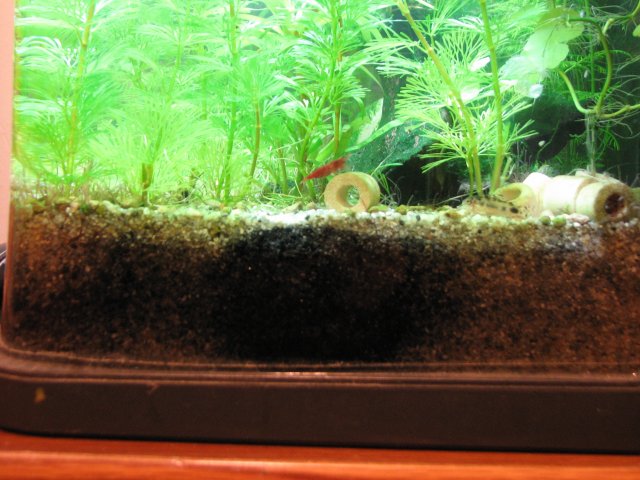
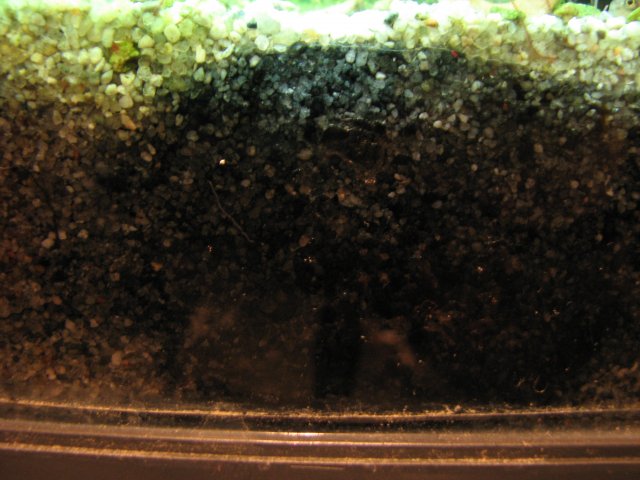
As mentioned in the blackworms thread, I had a dwarf gourami which died of fish TB (I think). I buried it deep under the sand about a year and a half ago to see if it would create a scary anoxic zone and also to see if it might make good fertilizer. I think it did both but I planted cabomba near it on the theory it would help neutralize at least some of the hydrogen sulfide and other toxins with the oxygen and aerobic bacteria which come with the roots. I also guessed the sand bed would be deep enough that aerobic bacteria in the upper reaches might have a chance on their own to neutralize the poisonous stuff.
There are roots penetrating into the very dark region of the aerobic or possibly anoxic zone surrounding the dead fish. There's actually a root that is sticking into a gas pocket as I write this. The gas pockets slowly move up through the sand and then release into the water to rise and pop harmlessly. Above the zone of anaerobic/anoxic decay is a very sharp border and only a very shallow aerobic layer of sand. Worms are living quite happily in that aerobic zone, untroubled by whatever is going on below them, which I take as evidence that any H2S or other toxins are not leaching up and out. Also, the cabomba are quite lush, which I think might have something to do with the nutrients leaching out of the poor little fishie. I'm not sure if the worms are contributing much in this case, though. I think they're more handy in encouraging oxygen and nitrate and mulm to diffuse downwards into the anaerobic zone and facilitate denitrifying bacteria (which will operate in very low oxygen but not totally oxygen deprived areas).
I'm including a photo of the zone o' fish decay which shows what I mentioned in the paragraph above.


i really enjoyed reading this thanks for posting. on a side note its stuff like this that moves the hobby forward, somebody has to try somethin new at some point. If noody did all we would hive in our tanks are betas and goldfish.
Thanks!
You know, I've said it before but I gotta say again the Diana Walstad's book, "Ecology of the Planted Aquarium" is what inspired me. Oh, and also Justin Hau's little store on Cedar off of Polk in San Francisco, Ocean Aquarium, http://oceanaquarium.blogspot.com/
I have to put in a plug for Justin for having one of the darn coolest LFS I ever did see! Also, his tanks all have deep sand beds, and heavily planted, and have low filtration levels (though he must sometimes hook up extra filtration in the form of a portable canister filter when the water clouds up because he stocks at fish shop levels [like a gazillion "inches per gallon"]). He uses no central filtration and sterilizes his nets, etc. so any disease which crops up stays where it started. Anyhow, check out the link I provided and enjoy his neat little site - see the pictures and note the species he carries!!!! I just love him and his wife Ady!
Anyhow, Justin's tanks set me on the path of exploration. He doesn't introduce worms or make little sanctuaries for them, nor does he add planaria, keep MTS in most of his tanks, leave in severed root systems, or a few other things I do but the DSBs do all the work - his filters are just mechanical (an often pretty clogged up at that) and rated for smaller tanks than they're attached to. He just uses that canister once in a while and also totally redoes the sand and plants every so often.
Once I read Walstad I knew I wanted a tank sort of like hers with great biofiltering and super fertile substrate, but with sand somehow instead so I could muck around with the plants more. That plus SW DSBs are so cool. Justin's approach seemed like the place to start.
like everyoen has already said, this is so cool!
keep it up and write a book/make a website or something, i bet people would benefit from it
keep it up and write a book/make a website or something, i bet people would benefit from it
CURSES!
:swear:CURSES! DARN DARN DARN DARN!
I measured the night stand which is the only place I've got room for an aquarium and its 15" by 19" which isn't quite big enough for the 24gal Nanocube at 18" by 19.6"
I'd decided on buying a 24gal 'cube and customizing it a little and now find I haven't room. You can't believe how disappointing it is! So, I think I'm gonna get an Oceanic 14gal Biocube. Crud. Still, that format is more than 50% larger than my current 9gal Odyssea B9. Too bad I love that wrap-around bowfront look and the cube shape so much. I just want the space in the aquarium to be empty of a heater, filter, etc. Just a plain cubic space. The back filter false wall in these 'cubes creates this. I'd be very much happier even with my B9 if the filter and heater didn't invade the space. But this is an aesthetic issue, not a DSB.
At this point I need to move to a larger tank 'cause my stocking level is really high. I'm not sure what kind of bioload the DSB will handle but I'm a little nervous. If I only had better impulse control when I see something in the LFS! Fortunately I'm too poor to buy everything I want. Plus I'm so eager to set up a tank more strictly following my ideal FWDSB.
My plan, whatever darn tank I get, is to document the process here, so there can be a record of how setting up a FWDSB aquarium goes. I'll also keep a notebook. I want this to be good!
Oh, here's another reason for the wraparound bowfront with integrated canopy look! My landlady is weird about electricity and is convinced that fish tanks use gobs of power - she doesn't understand really what watts are so I can't compare the tanks power use to a floorlamp and reassure her; she just doesn't freakin' get it and I KNOW she leaves her huge TV on all day for company!
So when I wanted a larger tank than my original cube-5, I mentioned it to her and she got upset. So I noticed the B9 looks a little like the Cube-5, so I got that and swapped. When she came in, I forget now what for, she looked right at it and didn't notice the difference. Now I want a bigger one but it has to look generally similar to the one before - this lady is so out of touch with reality she just doesn't notice subtle differences such as a 50% increase in size. I mean, she doesn't understand the difference between different wattage devices or that two things which use, say, 100 watts actually use the same amount of power no matter how different they are in function. Somehow, the TV's watts are less than an aquariums! Maybe because TVs don't have water in 'em. Honestly! She's a nut!
Maybe jumping up to a 24gal from a 9gal would have been enough that she'd've noticed now that I think about it. Probably 14gal is plenty.
Irrelevant to the topic but I think it's funny!
:swear:CURSES! DARN DARN DARN DARN!
I measured the night stand which is the only place I've got room for an aquarium and its 15" by 19" which isn't quite big enough for the 24gal Nanocube at 18" by 19.6"
I'd decided on buying a 24gal 'cube and customizing it a little and now find I haven't room. You can't believe how disappointing it is! So, I think I'm gonna get an Oceanic 14gal Biocube. Crud. Still, that format is more than 50% larger than my current 9gal Odyssea B9. Too bad I love that wrap-around bowfront look and the cube shape so much. I just want the space in the aquarium to be empty of a heater, filter, etc. Just a plain cubic space. The back filter false wall in these 'cubes creates this. I'd be very much happier even with my B9 if the filter and heater didn't invade the space. But this is an aesthetic issue, not a DSB.
At this point I need to move to a larger tank 'cause my stocking level is really high. I'm not sure what kind of bioload the DSB will handle but I'm a little nervous. If I only had better impulse control when I see something in the LFS! Fortunately I'm too poor to buy everything I want. Plus I'm so eager to set up a tank more strictly following my ideal FWDSB.
My plan, whatever darn tank I get, is to document the process here, so there can be a record of how setting up a FWDSB aquarium goes. I'll also keep a notebook. I want this to be good!
Oh, here's another reason for the wraparound bowfront with integrated canopy look! My landlady is weird about electricity and is convinced that fish tanks use gobs of power - she doesn't understand really what watts are so I can't compare the tanks power use to a floorlamp and reassure her; she just doesn't freakin' get it and I KNOW she leaves her huge TV on all day for company!
So when I wanted a larger tank than my original cube-5, I mentioned it to her and she got upset. So I noticed the B9 looks a little like the Cube-5, so I got that and swapped. When she came in, I forget now what for, she looked right at it and didn't notice the difference. Now I want a bigger one but it has to look generally similar to the one before - this lady is so out of touch with reality she just doesn't notice subtle differences such as a 50% increase in size. I mean, she doesn't understand the difference between different wattage devices or that two things which use, say, 100 watts actually use the same amount of power no matter how different they are in function. Somehow, the TV's watts are less than an aquariums! Maybe because TVs don't have water in 'em. Honestly! She's a nut!
Maybe jumping up to a 24gal from a 9gal would have been enough that she'd've noticed now that I think about it. Probably 14gal is plenty.
Irrelevant to the topic but I think it's funny!
Ammonia!!!!!!
I've got a lot to say today. So, I tested my water and found it at .25/0/10! I found a dead tiger shrimp and a dead super-red cherry shrimp. Darnit! I haven't had deaths for such a long time.
Well, the night before last, I moved around some plugs of hairgrass and a few lateral shoots from a variable leafed water hyacinth which I'd cut up into chunks (each chunk of stem with a shoot sticking out), and moved some water milfoil around. While moving this stuff around, I was careless and disturbed and unearthed two separate buried, rotting root systems which were both pretty far gone. No black sand came up with the roots, no dreaded bubbles, nothing scary looking except for black, crumbling roots.
That night the water was very slightly cloudy. Then yesterday it was cloudier and last night it was even a little more cloudy than in the latest photos I posted, and I found two dead shrimps. This AM the fish 'n inverts seem alright but hyper. The cloudiness has diminished. The PH is 6.4 and has been for weeks, so I'm hoping the ammonia isn't affecting the poor little guys too badly.
Anyhow, I'm going to seriously consider what to do with root systems when moving plants about. Sometimes there are good reasons to leave the roots to rot. The roots I accidently hooked with my planting tongs and pulled up were isolated from other root systems and could have easily been removed. Perhaps I should've removed them at the time. I'm thinking I've been too cavalier in leaving dead roots and burying dead critters. I'm thinking if I were to dig up the old gourami, it might poison the tank.
The plants whose roots were left in the sand are variable leafed water hyacinths, which grow quickly, usually with a single stem and developing a fairly extensive root system which can really disturb stuff if pulled up. They grow new roots very easily so when they're too tall, I just snip them off at the roots and trim bottom of the stem to the desired height and stick them back in the ground. In the little grove of them in the left side of the tank, I've done this over and over with no problems. They just seem to grow more and more lushly as time goes on. The roots which were unearthed had been in the middle, in an area I'd cleared of hyacinths a couple of months ago.
I've also been thinking about that old biomedia on the bottom. Is it contributing to the biofilter? In the next tank I'll use some pebbles instead. Also, I'd started using a little biomedia in the filter prior to getting my big idea about FWDSBs and I never though to quit using it, so there's a handful of it in my filter still, though it's really old and coated in crud - looks like diatoms and green algae - so I doubt it's much of a biofilter. In the next tank, there will be no added biomedia. Just either a sponge or filter floss for mechanical filtering. I know sponges can act as biomedia but I want mechanical - maybe I'll just use filter floss.
In an earlier post I said I didn't want a filter that would suck up the mulm but I have to admit that with no filtration, it would all be too much. Especially the particles which stay in suspension forever.
I'll keep the water quality posted. Next test is tonight. I have to admit, though, I panicked last night an put 2.5 ml of Amquel Plus in the tank, retested and found, as expected, ammonia at 0.0 ppm. I just was freaked that two shrimps were dead. I even though I'm experimental in approach, I care for the welfare of my little guys and try to look out for them.
Attached is a photo of the Variable Leafed Water Hyacinths.
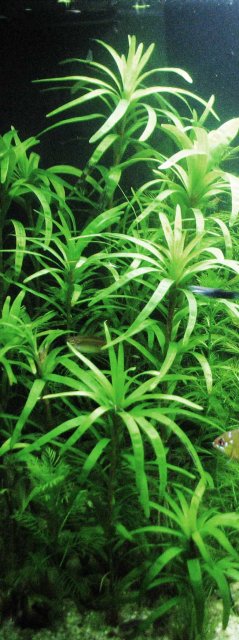
I've got a lot to say today. So, I tested my water and found it at .25/0/10! I found a dead tiger shrimp and a dead super-red cherry shrimp. Darnit! I haven't had deaths for such a long time.
Well, the night before last, I moved around some plugs of hairgrass and a few lateral shoots from a variable leafed water hyacinth which I'd cut up into chunks (each chunk of stem with a shoot sticking out), and moved some water milfoil around. While moving this stuff around, I was careless and disturbed and unearthed two separate buried, rotting root systems which were both pretty far gone. No black sand came up with the roots, no dreaded bubbles, nothing scary looking except for black, crumbling roots.
That night the water was very slightly cloudy. Then yesterday it was cloudier and last night it was even a little more cloudy than in the latest photos I posted, and I found two dead shrimps. This AM the fish 'n inverts seem alright but hyper. The cloudiness has diminished. The PH is 6.4 and has been for weeks, so I'm hoping the ammonia isn't affecting the poor little guys too badly.
Anyhow, I'm going to seriously consider what to do with root systems when moving plants about. Sometimes there are good reasons to leave the roots to rot. The roots I accidently hooked with my planting tongs and pulled up were isolated from other root systems and could have easily been removed. Perhaps I should've removed them at the time. I'm thinking I've been too cavalier in leaving dead roots and burying dead critters. I'm thinking if I were to dig up the old gourami, it might poison the tank.
The plants whose roots were left in the sand are variable leafed water hyacinths, which grow quickly, usually with a single stem and developing a fairly extensive root system which can really disturb stuff if pulled up. They grow new roots very easily so when they're too tall, I just snip them off at the roots and trim bottom of the stem to the desired height and stick them back in the ground. In the little grove of them in the left side of the tank, I've done this over and over with no problems. They just seem to grow more and more lushly as time goes on. The roots which were unearthed had been in the middle, in an area I'd cleared of hyacinths a couple of months ago.
I've also been thinking about that old biomedia on the bottom. Is it contributing to the biofilter? In the next tank I'll use some pebbles instead. Also, I'd started using a little biomedia in the filter prior to getting my big idea about FWDSBs and I never though to quit using it, so there's a handful of it in my filter still, though it's really old and coated in crud - looks like diatoms and green algae - so I doubt it's much of a biofilter. In the next tank, there will be no added biomedia. Just either a sponge or filter floss for mechanical filtering. I know sponges can act as biomedia but I want mechanical - maybe I'll just use filter floss.
In an earlier post I said I didn't want a filter that would suck up the mulm but I have to admit that with no filtration, it would all be too much. Especially the particles which stay in suspension forever.
I'll keep the water quality posted. Next test is tonight. I have to admit, though, I panicked last night an put 2.5 ml of Amquel Plus in the tank, retested and found, as expected, ammonia at 0.0 ppm. I just was freaked that two shrimps were dead. I even though I'm experimental in approach, I care for the welfare of my little guys and try to look out for them.
Attached is a photo of the Variable Leafed Water Hyacinths.



